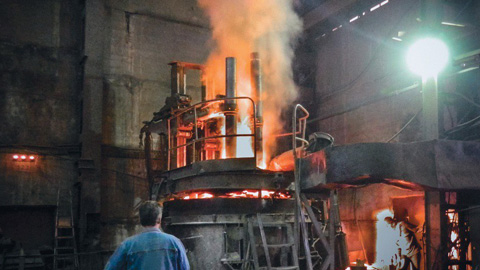In modern conditions, it is simply inconvenient to use anything other than LEDs in lighting projects – you risk being branded as a retrograde. So they put LED lamps not only in cool air-conditioned offices, but also in foundries, and even in baths. And only a bad operating experiences can teach some consumers that LEDs do not like high temperatures. Has modern technology not solved this problem?
The LED is a semiconductor device that is sensitive to temperature changes. With an increase in temperature, the number of defects in the crystal lattice increases, due to which the efficiency of the device decreases. The terminals through which the LED is powered are made of metal. As the temperature rises, the diffusion of metal atoms into the semiconductor structure increases, which also worsens the parameters of the LEDs. This is why as the temperature of the LED increases, its lifespan decreases.
White LEDs used for lighting have another “risk factor”. They have a crystal that gives blue radiation, covered with a layer of phosphor, due to which, as a result, a white glow is obtained. At high temperatures, the phosphor degrades, which is accompanied not only by a decrease in the luminous flux, but also by a change in the spectrum, in particular, an increase in the size of the so-called “blue peak” to values that are hazardous to health.
But how to determine the temperature limit to which LEDs and lamps based on them can be operated?
The temperature inside and outside
Looking at the technical data of a modern LED, you will find that it is usually capable of operating at temperatures up to +125°C. For more expensive and advanced LED models, the upper limit extends even higher. At the same time, the temperature in the Russian bath does not rise above +70°C, in the Finnish sauna – above +110°C. In the working area of the foundry, the temperature in reality is no more than +37.4°C. True, the lamps are installed there under the ceiling, where the temperature can reach + 60 ° C, but, anyway, it is much lower than the maximum allowable. It would seem that there are no problems for the introduction of LEDs. But this is only at first glance.
The technical data for the LED indicates the nominal and maximum allowable temperature values of the pn-junction. If we discard the technical details, then this indicator means the temperature inside the LED crystal. The maximum allowable temperature is the temperature above which the LED will fail very quickly. For the nominal temperature of the pn-junction, the manufacturer normalizes the main technical parameters. At lower temperatures than nominal, LEDs perform better than advertised. At higher ones, the service life is sharply reduced and energy efficiency drops. The most modern LEDs have a nominal pn-junction temperature of 85°C. That is, it is impossible to accurately put LED lamps in a Finnish sauna.
On an intuitive level, you can deduce the rule: the temperature inside the LED is higher than on the outer surface of its body. In turn, the outer surface of the lamp housing is heated to a lower temperature than the outer surface of the LED housing. But how can this be described in the form of formulas? To determine the service life of LEDs, a full run over the declared time is not used, since after 50,000 hours (more than 5 years), the tested LED model will simply become obsolete. Prototypes are tested for shorter periods (about 2000 hours) at elevated temperatures, then the degree of degradation is determined, based on which the service life at nominal temperature is calculated using special formulas.
Findings
Modern LEDs and drivers, specially designed for use at high temperatures, allow you to create LED luminaires that work reliably in production in hot shops, provided that the temperature at their place of installation does not exceed +60°C.
The use of LED lamps in a Russian bath in the case of a heat sink with liquid-filled tubes is possible, but from the point of view of economy, it is currently impractical.
The use of LEDs for interior lighting in a Finnish sauna is unacceptable.
In order to choose the right LED lamp for operation in high-temperature conditions, you should familiarize yourself with the technical characteristics of the LEDs used in it and the driver. Their parameters must be normalized at high temperatures (about +85°C). Without this data, a high limit temperature means nothing, as performance can drop significantly as you approach it.




